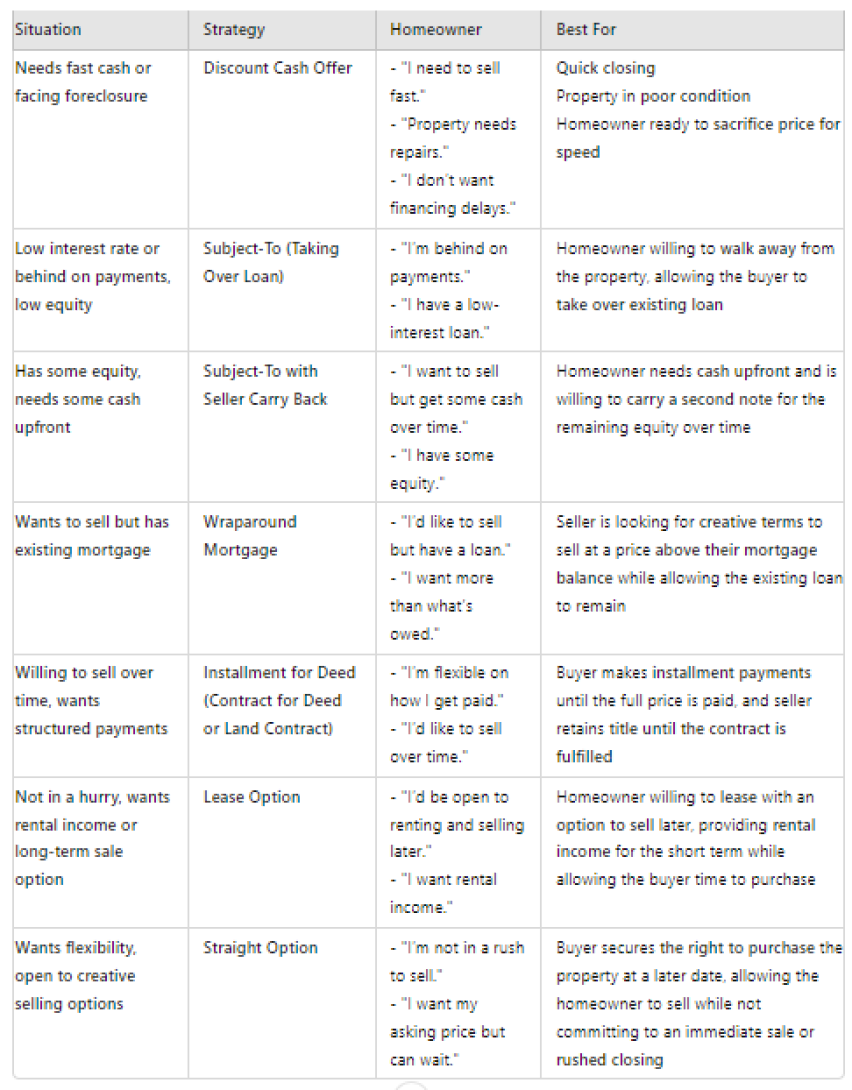Which Strategy Fits? Practice Picking The Right Strategy for The Deal
The Case Studies Game Part 1


The Case Studies Game Part 2
The Case Studies Game Part 3
Quiz/Test: Creative Real Estate Investing Strategies
Instructions: Read each case study carefully and select the best option (a, b, c, or d) based on the given scenario.
Case Study 1: Subject To
Scenario: John is a real estate investor looking to acquire a property with minimal upfront costs and without obtaining a new loan. He comes across a motivated seller who wants to sell their property but is concerned about their outstanding mortgage.
What is the primary benefit for John in a "subject to" transaction?
a) Obtain the property without qualifying for a new loan.
b) Assume personal liability for the loan.
c) Transfer the mortgage to a different lender.
d) Pay off the seller's outstanding mortgage balance.
Case Study 2: Seller Carry Back
Scenario: Sarah is a real estate investor interested in purchasing a property from a homeowner who owns it free and clear. The homeowner wants to sell but prefers to receive monthly payments instead of a lump sum.
How is the remaining purchase price typically financed in a seller carry back arrangement?
a) Through a promissory note from the buyer to the seller.
b) Through a conventional mortgage from a bank.
c) Through a personal loan from the seller's family member.
d) Through a credit card cash advance.
Case Study 3: Wraparound Mortgage
Scenario: Mark is considering buying a property from a seller who still has an existing mortgage. Mark wants to take over the seller's mortgage payments and offer additional financing to cover the remaining purchase price.
What is a key feature of a wraparound mortgage?
a) The buyer assumes the seller's existing mortgage and makes additional payments to the seller.
b) The buyer pays off the seller's outstanding mortgage balance at closing.
c) The buyer obtains a new loan from a different lender to cover the entire purchase price.
d) The seller finances the existing mortgage balance and the rest through a wraparound mortgage or promissory note to pay. Buyer pays seller.
Case Study 4: All Cash Discounted Offer
Scenario: Lisa is a cash buyer interested in acquiring a property at a discounted price from a motivated seller who wants to sell quickly.
What advantage does Lisa have as an all-cash buyer making a discounted offer?
a) Ability to close the transaction quickly and without financing contingencies.
b) Access to more favorable loan terms from lenders.
c) Higher likelihood of qualifying for a mortgage.
d) Lower closing costs compared to buyers obtaining financing.
Case Study 5: Lease Purchase
Scenario: David is considering a lease purchase strategy for a property he wants to eventually own. He wants to lease the property for a specific period and have the option to purchase it at the end of the lease term.
What is a key feature of a lease purchase agreement?
a) The buyer leases the property with the option to purchase at the end of the lease term.
b) The buyer assumes the seller's existing mortgage and makes regular payments.
c) The buyer and seller agree on seller financing with a carry back arrangement.
d) The buyer takes over the property subject to the existing mortgage.
Case Study 6: Straight Option to Purchase
Scenario: Emily wants to secure the right to purchase a property within a specified period at a predetermined price, but she's not yet ready to commit to the purchase.
What is the purpose of the option consideration in a straight option to purchase strategy?
a) To reduce the purchase price of the property.
b) To cover the seller's outstanding mortgage balance.
c) To secure the right to purchase the property within the option period.
d) To pay for property maintenance and expenses.


